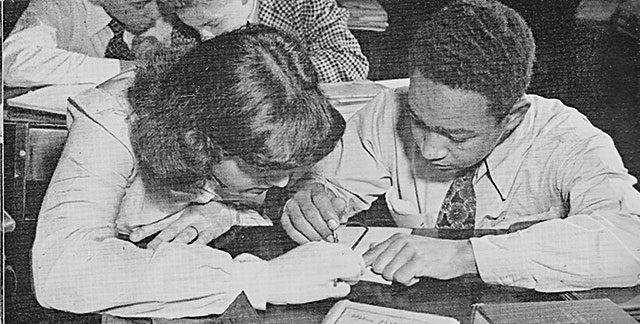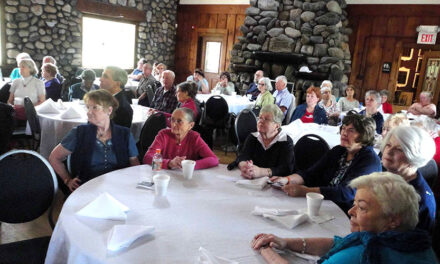Published February 26, 2021
This is the final part of a series.
By JAMES BENNETT
Melrose Historical Commission
They had been in Melrose since the beginning. The first time they came unwillingly, as enslaved people, the second time voluntarily, as equal citizens. But in the middle years of the twentieth century, most white people in Melrose told their Black neighbors that they would no longer be welcome here.

They did not say this with burning crosses and water hoses and openly hurled racial epithets. They said it through neighborly agreements not to sell their homes to the wrong sort of people, and through realtor tours which steered clients away from neighborhoods where they just would not fit in. Federal government policies rewarded communities that followed these white supremacist practices, but the consent of the governed was never in doubt. All of these strategies were pursued quietly, in language so coded that anyone using it could easily deny racist intent. Over time, most white people in the city became so inured to this new vocabulary that they forgot how to talk openly about race at all. A century after this era began, we are in many ways still living through it — and if we do not come to terms with that reality, this era will never end.
Until the second half of the nineteenth century, there were two sorts of places where one could live in America: the city, and the country. With the coming of the railroad, a third sort of place was invented, the suburb, which would come to dominate American life in the twentieth century. City planners of the late 19th century lauded the suburb for its healthy access to clean air and open country, but not for its racial purity. Even suburbs which had enclaves created specifically for people of extraordinary wealth needed to have neighborhoods nearby which could accommodate the people who served them. As was detailed in the last article in this series, 19th century Melrose very much followed that unsegregated pattern, with Black families owning homes in neighborhoods where they could afford them, and in the more exclusive neighborhoods living in the homes of white families for whom they worked.
Nonetheless, driven by the racist science of eugenics that was the intellectual current of the day, many white people began to dream of a racially pure living environment. In 1892, the Melrose author Samuel Adams Drake, who lived at 23 South Cedar Park, described a visit he took to the Paul Revere house in the North End, writing “Pah! The atmosphere is actually thick with the vile odors of garlic and onions — of maccaroni and lazzaroni. The dirty tenements swarm with greasy, voluble Italians…. One can scarce hear the sound of his own English mother-tongue from one end of the square to the other…. How those old fellows would have stared, to be sure, to hear of a Boston with an Italian quarter, a Chinese quarter, a Negro quarter, etc.!” We can imagine the relief Drake felt upon exiting the train at the Melrose Depot and finding the air thick with the smell of baked beans and the streets mainly full of white Protestants like himself.
Such personal racial preferences would remain just that until the early twentieth century, when explicit white supremacy became a powerful current in national politics and culture. By the 1910s, the generation that had fought in the Civil War had begun to die out; along with them, the last generation of Black Americans who could remember life under slavery was likewise rapidly perishing. In Melrose, the war to end slavery was honored through the construction of Memorial Hall in 1912, yet nationally, in 1915 the war was repudiated by the ticket sales for “Birth of a Nation,” a revisionist film which depicted slavery as benign, Black men as rapists, the Union Army as tyrants, and the Ku Klux Klan as the nation’s saviors. Ticket sales were brisk, and the film received presidential approval when Woodrow Wilson, a Southern Democrat, showed it at the White House. Wilson promoted a new model of full-fledged white supremacist American nationalism, moving to segregate federal offices and discourage black men from serving in the military.
In Melrose, Major Wesley Furlong railed against “Birth of a Nation” and Wilson’s segregationist policies. He served on the steering committee of the National Equal Rights League, a Boston-based civil rights organization that was led by and for Black people. In 1915, the N.E.R.L. sent a letter to Wilson signed by Furlong protesting the segregation of Washington D.C.’s public transit, in which they wrote “Never before in the century and a half of the Republic’s existence has such segregation been found necessary. Surely it is now too late in the day of advancing Christian civilization to inaugurate any such practice and infamy.” Furlong was eighty years old when he signed onto the letter, and had personally witnessed the demise of slavery and the “advance of civilization” in his own life. He had lived in Melrose for twenty-five years and had seen his children graduate from the city’s schools. We can only imagine his distress upon seeing that some of his own neighbors had embraced the new ethic of segregation and had come to believe the lies spun about his own past enslaved life in “Birth of a Nation.”
Much as Melrosians professed distaste for the reports of lynchings that came up from the South, there can be no doubt that many were attracted to segregationist policies. In 1916, a Black Melrose woman, Rosa Plunkett, experienced this sentiment firsthand. On a cold March day in 1916, she was taken by cab from her home at 313 East Foster Street to the New England Sanitarium in Stoneham, which is now a housing development at 5 Woodland Road. Rosa was about to give birth, and her husband Hugh had signed a contract for the doctors at the Sanitarium to care for Rosa when her time came. Upon reaching the hospital, she was made to wait in agony for two hours, only to be informed by a doctor that she would not be received, because her presence would be “an inconvenience” for the white women in the maternity ward. She waited through the night until a cab became available, and the next morning was taken to a hospital in Boston that would accept Black women as patients. There, her son Charles was born.
The following Saturday, Melrosians gathered in Memorial Hall for a protest meeting presided over by Mayor Charles H. Adams. Local clergy gave rousing speeches decrying the treatment of Rosa Plunkett, as did Butler R. Wilson, the Plunketts’ attorney from the N.A.A.C.P. The gathering endorsed a declaration against racial discrimination. Yet what may have been most striking about this event was its anemic attendance. Only one Boston newspaper covered the meeting, and it estimated the crowd at about 100; by comparison, when the First Baptist Church across the street had first opened its doors in 1907, attendance at that first service had been estimated at 1700. A couple of weeks after the Plunkett protest event, at a dinner at Memorial Hall honoring C. F. Slayton, newspapers reported that hundreds attended. If this event was a gauge of Melrose opposition to segregation, the indications were not promising.
Following their ordeal, the Plunketts moved from Melrose to Malden. Upon his death in 1918, Wesley Furlong’s children sold the family house and moved first to Cambridge, and later to Roxbury. They were part of a new migration pattern that saw Black families forced out of Melrose and into neighborhoods closer to downtown Boston. Between 1920 and 1930, before government policies gave impetus to the segregation movement, the Black community in Melrose was reduced by almost fifty percent. While the precise decision-making pattern that led to this reversal remains difficult to interpret, the surprising fate of a Melrose street called Ingalls Court provides a clue. Ingalls Court is located off of Main Street, just south of East Emerson. Today it is the site of a medical office building. A century ago, it was home to a row of houses that for a period of about thirty years were exclusively inhabited by Black migrants from the South. In 1927, quite suddenly, all of the listings of Black residents on the street disappeared from the city directory, and they were replaced by poor immigrants from Europe and Canada. The complete racial replacement of the residents in one fell swoop, coming during good times before the crash of 1929, argues that there were forces in Melrose deliberately working to displace Black residents from the city.
The practice of segregation in Melrose was given government support in 1933 by President Roosevelt’s establishment of the Home Owners’ Loan Corporation. The H.O.L.C. provided low-interest government loans to homebuyers. To provide guidance for local real estate agents, developers, and banks, the agency created a series of color-coded maps grading neighborhoods by the risk of investment. These grades were in turn based on evaluations submitted to the agency by the very same real estate agents, developers, and banks that they were supposed to inform, creating a closed circle of knowledge and power. These “redlining maps,” as they are now usually known, are often popularly interpreted as a top-down, government imposition of segregation onto an unsuspecting and unwilling professional class. On the contrary, the redlining maps were based on the perceptions and desires of white real estate professionals. They codified and gave new financial incentives for their pre-existing practices, and provide a glimpse into their collective mindset in the 1930s.
What we find is a professional culture profoundly obsessed with race, using language that we might more often associate with contemporary developments on the other side of the Atlantic. The evaluation sheets for Melrose, which had no redlined districts, have not yet turned up. In neighboring Malden, the sheet for one redlined neighborhood south of Salem Street complains of “the infiltration of Jews,” and that “the neighborhood has been largely Jewish for some time, with lower class Jews moving into the neighborhood at present.” It also notes that the district is “2% Negro.” The only neighborhood in Malden that received the second-highest, blue rating, located around Fellsmere Pond, was noted for its infiltration of “better-class Jews” but that “there is a tendency for the better class to move into the adjoining town of Melrose.”
The lessons of the redlining maps were clear: the racial composition of a district was ultimately more important than the actual quality of the housing stock. Analogous neighborhoods in Malden and Melrose, although just a mile or two apart and to all appearances of similar quality, were judged to be of differing investment value because of the people who were living there. This message, long spoken among developers, was now taught to homeowners. Based on the Malden evaluation form’s obsession with Jews, this lesson likely included a hefty dose of anti-Semitism that limited the migration of Jews from Malden to Melrose. In the case of Black people, the message was more extreme. Whereas the mapmakers conceptualized Jews as coming in lower and higher-class varieties, Black people by their essential nature were considered unacceptable. The message went out that the “infiltration” of a single Black family in the neighborhood would destroy the value of all of the surrounding homes there. The results were catastrophic for Melrose’s Black community, virtually wiping it out. By 1950, the census revealed only twelve Black people living in Melrose, the lowest number since the city had been founded a century before.
The segregationist dream had come true in Melrose. Just as more and more Black people were leaving the South to find their fortunes in big northern cities like Boston, they were forced into derelict neighborhoods that had been abandoned by white families, as suburbs like Melrose remained closed to them as effectively as if they had been surrounded by walls. Only part of this blame can be laid at the feet of government. In 1946, Massachusetts passed a fair housing law that barred discrimination based on race. For this reason, the explicit racial covenants and racist deed restrictions seen in other states are not in evidence in the postwar Melrose housing market. Instead, racist principles had to be articulated using coded language. An early example of this language can be found in an editorial in the Boston Herald in 1934 explaining why Melrose was the only large city in Massachusetts to vote to keep the ban on alcohol sales in that year: “The people are public-spirited, interested in culture, proud of their schools and playgrounds, their streets and lawns…. They are quite content to be “different” and many of the more discerning insist that their differences constitute an asset of high value.” Forty years before, Samuel Adams Drake had complained of the scent of garlic and onions; Melrosians in the twentieth century had learned to speak their racist disdain in roundabout language, making only vague references to a certain superior “discernment.”
In the 1960s, Melrose would have to confront what that “discernment” really meant. In 1963, Floyd W. McLaughlin, a white man known for his outspoken support of Black civil rights, was working to repair the gutters at 9 Simonds Road, the home of one of the only Black residents of the city, Stanley C. Harris. A passing white driver threatened him for working on Harris’s house. Over the course of the next week, the tires were slashed, the ignition cut, and the wheel lugs loosened on McLaughlin’s car. This campaign of white supremacist terror culminated in Molotov cocktails being thrown onto the porch of McLaughlin’s house at 59 Orient Avenue while he and his family lay sleeping. The frightened family fled the flames only to find (a nasty racist message, misspelled) painted in huge letters on the side of the house. Thinking of the safety of his five children, McLaughlin moved from Melrose, after threatening to sell the property to a Black family, much to the chagrin of his neighbors.
No one immediately rose to take up McLaughlin’s cast-off cross, but three years later, a ministry at the city’s Unitarian church formed the nucleus of what became a citywide activist organization called the Melrose Civil Rights Committee. They published a pamphlet in which they called on people in Melrose to end housing segregation. They wrote “In our society, segregation is a pattern, a way of life…. Although Northerners do not legislate segregation, we have developed remarkably efficient techniques for maintaining it.” The Committee described “areas of Melrose where one violates the “Gentleman’s Agreement” by selling or renting to a Jew or a Catholic or an Italian.” On Black homeownership in Melrose, the Committee dolefully concluded that “prejudice against the Negro is so deep-seated that, even with the weight of law against it, it will be with us for many more generations.”
In hindsight, we now know that the committee was correct. In the wake of Martin Luther King’s murder, Congress finally summoned the courage to pass the Civil Rights Act of 1968, which brought the legal era of federally mandated segregation to an end. The reality of segregation, however, has been slow to die. President Nixon’s Southern strategy was based on appeasement of segregationists, and he deliberately undermined the plan for equitable housing put forth by his own Secretary of Housing and Urban Development, George Romney. No presidential administration has touched the subject in a meaningful way since. The Massachusetts affordable housing law passed in 1969, M.G.L. Chapter 40B, has for over fifty years existed primarily to enrich developers at the expense of communities, and has utterly failed to create sufficient affordable housing stock in the Boston area for people of all races. In 1974, Boston’s attempt at school desegregation caused more white flight to suburbs like Melrose. Aside from the bright spot of the Metco program, which has brought some level of racial diversity to the Melrose schools, government at all levels has proven unable to mitigate a segregation problem it had a large role in creating.
Despite these failures, we are now living in the age of Melrose’s third Black community. At some point between the 1990 and 2000 censuses, Melrose’s Black population rose to include just under 1% of the city’s people. It took eighty years, but the population had finally exceeded the previous highpoint that had been achieved around 1920, just before segregation began in earnest. In the past generation, that population has grown steadily, fueled largely by recent Black immigrants to the United States and their children. In a sign of the importance of those communities, Melrose’s first two Black-run institutions, the Redeemed Christian Church of God on Upham Street, and the Grace and Faith Christian Church on Main Street, were founded by Nigerian and Haitian migrant groups respectively. Despite the most unforgiving housing market in the city’s history, the 2020 census should reveal that the Black community has reached its highest numbers ever.
The story of that present-day community will have to await another time, and another writer whose talents for journalism are more honed than mine. I thank everyone who has read through these articles to the end. My goal in writing them was to establish a shared context and set of reference points for understanding the history of race and racism in Melrose. One unintended consequence of the long era of segregation has been the lost ability among white Melrosians to articulate race-related issues in our community. I hope that, in one way or another, this reading has helped to loosen tongues, make conversation more fluid, and grant us a shared, expressive vocabulary. Together, we can find our way out of this labyrinth of white supremacy.
The author invites readers to visit the social media pages of the Melrose Historical Commission, including Facebook and Instagram, where they can find supplementary images and text related to this story.




